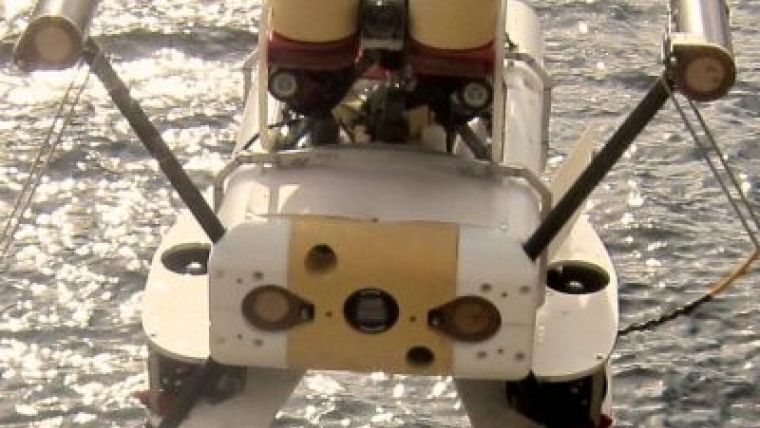ROVs in Use for Renewables
Saab Seaeye
The renewable energy sector is a significant user of Saab Seaeye underwater vehicles. Already the world’s largest manufacturer of electric ROVs, Saab Seaeye also has a range of autonomous and tethered AUV/ROV hybrid systems that will extend the potential for remote inspection and monitoring in the renewable sector.
Since its foundation in 1986, the Fareham, UK-based company has pioneered many innovations that have set standards for electric vehicles across the ROV industry.
Leading-edge technology has created systems capable of fulfilling highly specific operational needs in various industries, the renewable energy sector being a clear example.
In this sector underwater vehicles must master the particularly challenging environments in which renewable energy installations are set. Typically they are built in shallow waters where high currents and wave action demand powerfully swimming vehicles that will hold steady whilst undertaking precise tasks or making accurate observations. They must also operate in poor visibility and manoeuvre deftly in tight spaces.
The underwater vehicle technology needed for such conditions has been developed and refined over the years by Saab Seaeye who have created a wide range of vehicles able to cope with severe environments whilst undertaking an extensive spread of tasks.
By introducing intelligent behaviour-based architecture, called iCON, and also designing vehicles with the maximum thrust power, operators in the renewable sector benefit from the resulting control and power that provides them with a stable platform from which to handle an array of sensor systems and tooling options whilst remaining on station in strong tides.
Such technological advances are meeting the challenges presented by the renewable sector that are both broad and varied, some examples of which follow.
Renewable Energy Installations and Marine Animals
The long-term effect of renewable energy installations on marine animals is to be investigated by researchers at Washington University. A specially designed underwater monitoring system with a detachable instrument pod deployed by a Saab Seaeye Falcon ROV will gather information on how marine life interacts with renewable installations used to harvest wave and tidal energy.
The instrument pod can monitor marine mammals and detect fish tags. It also has a sonar system, sensors to gauge water quality and speed, and a stereo camera to collect photos and video. A fibre optic cable connection allows for real-time monitoring and control.
The system can attach to most types of underwater infrastructure, with the instrument pod delivered to its docking station by the Falcon ROV.
Actuators on the Falcon latch the monitoring instruments onto the docking station before the ROV disengages, leaving the instruments in place and travelling back to the surface.
Despite the monitoring package being almost twice the size of the Falcon (Figure 1) the researchers were able to fit an off-the-shelf Falcon with five extra thrusters on an external frame to move the mass of the instrumentation package against turbulent currents.
The University sees the system as key technology for the future of monitoring tidal energy systems that will increase the rate of progress in environmental studies, including research into other structures that form artificial reefs like oil and gas rigs.
Securing Floating Turbines
After Japan’s 50 nuclear reactors closed, following the Fukushima disaster, wind is now seen as an important alternative energy source. But in a crowded and mountainous country, floating turbines in the deep waters off the rugged coastline was the only option.
With many turbines to be installed at a depth of 100 metres or more, sure-footed anchorage to the seabed is a vital necessity. To monitor the integrity of chained mooring points the Japanese Government uses a Saab Seaeye Falcon ROV to assess anchor holding, analyse anchor drag and check for twist and entanglement.
The Ministry chose the Falcon because it can be deployed from a small workboat at a low operating cost and can handle strong currents (Figure 2).
Finding Cables in Offshore Wind High Current Sites
UK-based Innovatum has created the world’s smallest package for the location, tracking and survey of inshore and coastal pipelines and cables. To handle the six-metre wide gradiometer array in the strong currents and tidal flows of the southern North Sea, the company has opted for the compact version of Saab Seaeye’s Cougar XT with its six-strong thruster power, advanced systems and low profile.
Innovatum has also fitted the ROV with a high-resolution imaging sonar and dual-headed scanning profiler for mean seabed level measurement. For survey work, the Cougar has the advantage of a low electrical and acoustic noise signature for optimum survey sensor data.
The Innovatum system is said to be the only one in the world that can sense cables carrying either AC or DC current; and cables carrying no current or signal at all. It can also undertake passive tracking of steel pipelines.
Mastering Strong Currents
Extending the working window offers significant operational and cost advantages say Keynvor MorLift who opted for Seaeye Cougar-XT systems (Figure 4) to undertake their installation and maintenance work at tidal energy sites where exceptionally strong tidal currents occur.

Value staying current with hydrography?
Stay on the map with our expertly curated newsletters.
We provide educational insights, industry updates, and inspiring stories from the world of hydrography to help you learn, grow, and navigate your field with confidence. Don't miss out - subscribe today and ensure you're always informed, educated, and inspired by the latest in hydrographic technology and research.
Choose your newsletter(s)
























